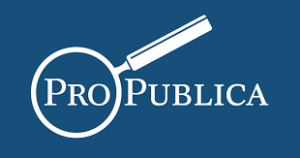
By Robert Faturechi, ProPublica & Danielle Ivory, The New York Times,
ProPublica (7/11/17)
President Trump entered office pledging to cut red tape, and within weeks, he ordered his administration to assemble teams to aggressively scale back government regulations.
But the effort — a signature theme in Trump’s populist campaign for the White House — is being conducted in large part out of public view and often by political appointees with deep industry ties and potential conflicts.
Most government agencies have declined to disclose information about their deregulation teams. But ProPublica and The New York Times identified 71 appointees, including 28 with potential conflicts, through interviews, public records and documents obtained under the Freedom of Information Act.
Some appointees are reviewing rules their previous employers sought to weaken or kill, and at least two may be positioned to profit if certain regulations are undone.
There are appointees with potential conflicts of interest, including two who might personally profit if particular public protections are undone.
The appointees include lawyers who have represented businesses in cases against government regulators, staff members of political dark money groups, employees of industry-funded organizations opposed to environmental rules and at least three people who were registered to lobby the agencies they now work for.
At the Education Department alone, two members of the deregulation team were most recently employed by pro-charter advocacy groups or operators, and one appointee was an executive handling regulatory issues at a for-profit college operator.
So far, the process has been scattershot. Some agencies have been soliciting public feedback, while others refuse even to disclose who is in charge of the review. In many cases, responses to public records requests have been denied, delayed or severely redacted.
The Interior Department has not disclosed the correspondence and calendars for its team. But a review of more than 1,300 pages of handwritten sign-in sheets for guests visiting the agency’s headquarters in Washington found that appointees had met regularly with industry representatives.
Over a four-month period, from February through May, at least 58 representatives of the oil and gas industry signed their names on the agency’s visitor logs before meeting with appointees.
The EPA also rejected requests to release the appointment calendar of the official leading its team — a former top executive for an industry-funded political group — even as she met privately with industry representatives.
And the Defense Department and the Department of Homeland Security provided the titles for most appointees to their review teams, but not names.
When asked for comment about the activities of the deregulation teams, the White House referred reporters to the Office of Management and Budget.
Meghan Burris, a spokeswoman there, said: “As previous administrations have recognized, it’s good government to periodically reassess existing regulations. Past regulatory review efforts, however, have not taken a consistent enough look at regulations on the books.”
With billions of dollars at stake in the push to deregulate, corporations and other industry groups are hiring lawyers, lobbyists and economists to help navigate this new avenue for influence. Getting to the front of the line is crucial, as it can take years to effect regulatory changes.
“Competition will be fierce,” the law firm Clark Hill, which represents businesses pitching the Environmental Protection Agency, said in a marketing memo. “In all likelihood, interested parties will need to develop a multi-pronged strategy to expand support and win pre-eminence over competing regulatory rollback candidates.”
Jane Luxton, a lawyer at the firm, said she advised clients to pay for economic and legal analyses that government agencies, short on staff, could use to expedite changes. She declined to identify the clients. …
(This story was co-published with The New York Times.)
*****
Help Us Identify The Officials Helping Trump Destroy Public Protections
(Editor’s Note: If you know someone working in a federal protection agency, like the EPA, forward this information to them – but not to their government email address. – Mark L. Taylor)
By Robert Faturechi, Al Shaw, Terry Parris Jr. ProPublica & Danielle Ivory, The New York Times
ProPublica (7/11/17)
In February, President Trump ordered federal agencies to form task forces charged with finding regulations to weaken or eliminate. While the names of appointees to executive-agency task forces are typically made public, some agencies are refusing to reveal who is on their panels. The New York Times and ProPublica have been trying to identify them — through interviews, public records and Freedom of Information Act requests — but many still remain unknown.
Why is this important? Identifying task-force members allows us to examine their backgrounds for potential conflicts. We’ve already found that many may be reviewing regulations that their previous employers tried to weaken or kill, and a couple may personally profit if regulatory changes are made.
Here’s who we’ve found so far. If you know additional names or information about these task forces, contact us at taskforce@propublica.org or via Signal at 213-271-7217.

